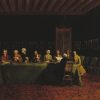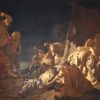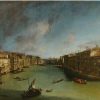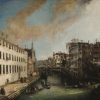In the second-floor portego some of the most important paintings in the museum are displayed. These provide excellent examples of the various painting genres of 18th-century Venetian art: the veduta (or “view”), the landscape, the capriccio, the portrait and the figure painting.
The Dutch Diplomatic Meeting by Francesco Guardi, a work which refers to a precise historical event, the trading agreement signed in The Hague on 27th August 1753 between the Kingdom of Naples and Holland. The painting was commissioned by Count Finocchiatti, the representative of the Bourbon sovereign, who immediately after the event came to Venice and commissioned the work. Together with the other works by Francesco Guardi in Ca’ Rezzonico such as the Foyer, the Parlatory of the Nuns, the Signboard of the Guild of the Coroneri (or rosary-makers), it forms the most important group of interiors by this artist present in a public collection.
On the opposite wall is the large canvas of the Death of Darius, painted in about 1746 by Giambattista Piazzetta for the portego of Palazzo Pisani Moretta at San Polo, where it was paired with a painting by Paolo Veronese showing Alexander and Darius’ Family, later sold by the owners to the National Gallery of London. The Death of Darius is one of the great master’s most important works. All the particular features of his style, so different from that of his contemporary and rival Tiepolo, can be recognised in it. The atmosphere is gloomy and dramatic, an effect which has been emphasised by alterations in the colours which have occurred due to the priming with Armenian bole. Over the centuries this priming has absorbed and cancelled some hues, such as the pinks and light blues. Piazzetta’s rendering of faces and gestures is the result of careful meditation, in contrast to Tiepolo’s quick, free brush strokes. Piazzetta also impeccably defines the anatomy of the nude, as can be observed in the extraordinary image of the Persian king’s outstretched body.
A stucco frame surrounds a painting by Gian Antonio Pellegrini showing Mutius Scaevola Standing before Porsenna. This is a fine example of the late work of this major exponent of international rococo, which was wholly concentrated on painting techniques. He uses a rapid, loose application of contrasting, clashing colours.
The next part of the wall is dedicated to the display of the two early masterpieces by Canaletto, View of the Grand Canal from Ca’ Balbi towards Rialto, and Rio dei Mendicanti (the Beggars’ Canal). These are the only two views by the master which can be seen in the public collections of Venice. These paintings were originally part of a series of four, belonging to the Princes of Liechtenstein. The other two are today in the Thyssen-Bornemisza museum of Madrid). In the first painting Canaletto exalts the particular nature of Venice as a “city of water”, expanding the true width of the Grand Canal. Sunlight breaks in from the right, illuminating even the smallest element of the composition, and making even the most distant buildings distinctly perceptible. Within the perspective structure Canaletto builds up a stupefying realism which is obtained through an extraordinary use of light. Nor does he hide the signs of the pictorial operation; indeed he exhibits them bared-facedly: loaded, frayed brush strokes which offer the viewer a more ‘realistic’, more lively, interpretation of the town. Canaletto adds views which had formerly been ignored to the standard repertoire, which concentrated on the area around St. Mark’s Square. These included both the Grand Canal and little-known corners of Venice, one of which was this Rio dei mendicanti, in which the artist depicts a popular district and describes it in all its plebean beauty.
The opposite wall features The Feast of St. Martha by Gaspare Diziani.
The large painting depicts the feast, or eve, of St. Martha’s Day, a popular festival that was celebrated the night before the anniversary of the saint in front of the eponymous church located at the westernmost end of Zattere. It is a unique example in the production of Gaspare Diziani, whose work can be admired in the palace also in the frescoed ceiling of the Pastel Room on the first floor. In this painting he managed to capture a striking picture of Venetian life. In using a nocturnal setting and a vivid description of the revellers, from all different social classes and caught in a private moment of merriment, Diziani offers us one of the most convincing examples of his prolific activity while making us relive the atmosphere of eighteenth century Venice.





